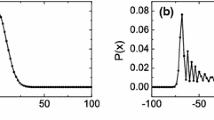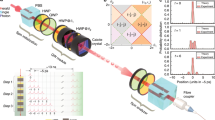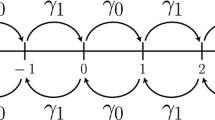Abstract
The discrete-time quantum walk dynamics can be generated by a time-dependent Hamiltonian, repeatedly switching between the coin and the shift generators. We change the model and consider the case where the Hamiltonian is time-independent, including both the coin and the shift terms in all times. The eigenvalues and the related Bloch vectors for the time-independent Hamiltonian are then compared with the corresponding quantities for the effective Hamiltonian generating the quantum walk dynamics. Restricted to the non-localized initial quantum walk states, we optimize the parameters in the time-independent Hamiltonian such that it generates a dynamics similar to the Hadamard quantum walk. We find that the dynamics of the walker probability distribution and the corresponding standard deviation, the coin-walker entanglement, and the quantum-to-classical transition of the discrete-time quantum walk model can be approximately generated by the optimized time-independent Hamiltonian. We, further, show both dynamics are equivalent in the classical regime, as expected.







Similar content being viewed by others
References
Portugal, R.: Quantum Walks and Search Algorithms. Springer, New York (2013)
Venegas-Andraca, S.E.: Quantum walks: a comprehensive review. Quantum Inf. Process. 11(5), 1015–1106 (2012)
Lovett, N.B., Cooper, S., Everitt, M., Trevers, M., Kendon, V.: Universal quantum computation using the discrete-time quantum walk. Phys. Rev. A 81, 042330 (2010)
Genske, M., Alt, W., Steffen, A., Werner, A.H., Werner, R.F., Meschede, D., Alberti, A.: Electric quantum walks with individual atoms. Phys. Rev. Lett. 110, 190601 (2013)
Cedzich, C., Rybár, T., Werner, A.H., Alberti, A., Genske, M., Werner, R.F.: Propagation of quantum walks in electric fields. Phys. Rev. Lett. 111, 160601 (2013)
Kitagawa, T., Rudner, M.S., Berg, E., Demler, E.: Exploring topological phases with quantum walks. Phys. Rev. A 82, 033429 (2010)
Kitagawa, T.: Topological phenomena in quantum walks: elementary introduction to the physics of topological phases. Quantum Inf. Process. 11(5), 1107–1148 (2012)
Asbóth, J.K.: Symmetries, topological phases, and bound states in the one-dimensional quantum walk. Phys. Rev. B 86, 195414 (2012)
Asbóth, J.K., Obuse, H.: Bulk-boundary correspondence for chiral symmetric quantum walks. Phys. Rev. B 88, 121406 (2013)
Obuse, H., Asbóth, J.K., Nishimura, Y., Kawakami, N.: Unveiling hidden topological phases of a one-dimensional hadamard quantum walk. Phys. Rev. B 92, 045424 (2015)
Cedzich, C., Grünbaum, F., Stahl, C., Velázquez, L., Werner, A., Werner, R.: Bulk-edge correspondence of one-dimensional quantum walks. J. Phys. A Math. Theor. 49(21), 21LT01 (2016)
Schumacher, B., Werner, R.F.: Reversible quantum cellular automata. arXiv preprint arXiv:quant-ph/0405174 (2004)
Arrighi, P., Grattage, J.: Partitioned quantum cellular automata are intrinsically universal. Nat. Comput. 11(1), 13–22 (2012)
D’Ariano, G.M., Perinotti, P.: Derivation of the dirac equation from principles of information processing. Phys. Rev. A 90, 062106 (2014)
Bisio, A., D’Ariano, G.M., Perinotti, P., Tosini, A.: Weyl, dirac and maxwell quantum cellular automata. Found. Phys. 45(10), 1203–1221 (2015)
Feynman, R.P., Hibbs, A.R.: Quantum Mechanics and Path Integrals, Emended edn. Dover Publications Inc, Mineola (2005)
D’Ariano, G.M., Mosco, N., Perinotti, P., Tosini, A.: Path-integral solution of the one-dimensional dirac quantum cellular automaton. Phys. Lett. A 378(43), 3165–3168 (2014)
D’Ariano, G.M., Mosco, N., Perinotti, P., Tosini, A.: Discrete feynman propagator for the weyl quantum walk in 2 + 1 dimensions. EPL 109(4), 40012 (2015)
D’Ariano, G.M., Mosco, N., Perinotti, P., Tosini, A.: Path-sum solution of the weyl quantum walk in 3 + 1 dimensions. Philos. Trans. R. Soc. A 375(2106), 20160394 (2017)
Bisio, A., D’Ariano, G., Mosco, N., Perinotti, P., Tosini, A.: Solutions of a two-particle interacting quantum walk. Entropy 20(6), 435 (2018)
Nielsen, M.A., Chuang, I.L.: Quantum Computation and Quantum Information. Cambridge University Press, New York (2010)
Travaglione, B., Milburn, G.: Implementing the quantum random walk. Phys. Rev. A 65(3), 032310 (2002)
D’Ariano, G.M., Mosco, N., Perinotti, P., Tosini, A.: Discrete time dirac quantum walk in 3+1 dimensions. Entropy 18(6), 228 (2016)
Strauch, F.W.: Relativistic quantum walks. Phys. Rev. A 73, 054302 (2006)
Strauch, F.W.: Relativistic effects and rigorous limits for discrete- and continuous-time quantum walks. J. Math. Phys. 48(8), 082102 (2007)
Suzuki, M.: Decomposition formulas of exponential operators and Lie exponentials with some applications to quantum mechanics and statistical physics. J. Math. Phys. 26, 601 (1985)
Suzuki, M.: Generalized Trotter’s formula and systematic approximants of exponential operators and inner derivations with applications to many-body problems. Commun. Math. Phys. 51(2), 183–190 (1976)
Pollard, D.: A User’s Guide to Measure Theoretic Probability, vol. 8. Cambridge University Press, Cambridge (2002)
Alagic, G., Russell, A.: Decoherence in quantum walks on the hypercube. Phys. Rev. A 72, 062304 (2005)
Drezgich, M., Hines, A.P., Sarovar, M., Sastry, S.: Complete characterization of mixing time for the continuous quantum walk on the hypercube with markovian decoherence model. Quantum Inf. Comput. 9(9), 856–878 (2009)
Artiles, L.M., Gill, R.D., Guta, M.I.: An invitation to quantum tomography. J. R. Stat. Soc. B 67(1), 109–134 (2005)
Dajka, J., Łuczka, J., Hänggi, P.: Distance between quantum states in the presence of initial qubit-environment correlations: a comparative study. Phys. Rev. A 84, 032120 (2011)
Belavkin, V.P., D’Ariano, G.M., Raginsky, M.: Operational distance and fidelity for quantum channels. J. Math. Phys. 46(6), 062106 (2005)
Marian, P., Marian, T.A.: Hellinger distance as a measure of Gaussian discord. J. Phys. A Math. Theor. 48(11), 115301 (2015)
Roga, W., Spehner, D., Illuminati, F.: Geometric measures of quantum correlations: characterization, quantification, and comparison by distances and operations. J. Phys. A Math. Theor. 49(23), 235301 (2016)
Suciu, S., Isar, A.: Gaussian geometric discord in terms of hellinger distance. AIP Conf. Proc. 1694, 020013 (2015)
Girolami, D., Tufarelli, T., Adesso, G.: Characterizing nonclassical correlations via local quantum uncertainty. Phys. Rev. Lett. 110, 240402 (2013)
Chang, L., Luo, S.: Remedying the local ancilla problem with geometric discord. Phys. Rev. A 87, 062303 (2013)
Manouchehri, K., Wang, J.: Physical Implementation of Quantum Walks. Springer, Berlin (2014)
Schmitz, H., Matjeschk, R., Schneider, C., Glueckert, J., Enderlein, M., Huber, T., Schaetz, T.: Quantum walk of a trapped ion in phase space. Phys. Rev. Lett. 103(9), 090504 (2009)
Zähringer, F., Kirchmair, G., Gerritsma, R., Solano, E., Blatt, R., Roos, C.F.: Realization of a quantum walk with one and two trapped ions. Phys. Rev. Lett. 104(10), 100503 (2010)
Sanders, B.C., Bartlett, S.D., Tregenna, B., Knight, P.L.: Quantum quincunx in cavity quantum electrodynamics. Phys. Rev. A 67(4), 042305 (2003)
Hardal, A.Ü., Xue, P., Shikano, Y., Müstecaplıoğlu, Ö.E., Sanders, B.C.: Discrete-time quantum walk with nitrogen-vacancy centers in diamond coupled to a superconducting flux qubit. Phys. Rev. A 88(2), 022303 (2013)
Moqadam, J.K., Portugal, R., de Oliveira, M.C.: Quantum walks on a circle with optomechanical systems. Quantum Inf. Process. 14(10), 3595–3611 (2015)
Ramasesh, V.V., Flurin, E., Rudner, M., Siddiqi, I., Yao, N.Y.: Direct probe of topological invariants using Bloch oscillating quantum walks. Phys. Rev. Lett. 118, 130501 (2017)
Flurin, E., Ramasesh, V.V., Hacohen-Gourgy, S., Martin, L.S., Yao, N.Y., Siddiqi, I.: Observing topological invariants using quantum walks in superconducting circuits. Phys. Rev. X 7, 031023 (2017)
Suzuki, M.: On the convergence of exponential operators—the Zassenhaus formula, BCH formula and systematic approximants. Commun. Math. Phys. 57(3), 193–200 (1977)
Vidal, G., Werner, R.F.: Computable measure of entanglement. Phys. Rev. A 65, 032314 (2002)
Kendon, V.: Decoherence in quantum walks—a review. Math. Struct. Comput. Sci. 17(06), 1169–1220 (2007)
Blais, A., Huang, R.S., Wallraff, A., Girvin, S.M., Schoelkopf, R.J.: Cavity quantum electrodynamics for superconducting electrical circuits: an architecture for quantum computation. Phys. Rev. A 69, 062320 (2004)
Acknowledgements
JKM acknowledges financial support from Iran’s National Elites Foundation, Grant No. 7000/2000-1396/03/08. MCO acknowledges supports by the Fundação de Amparo à Pesquisa do Estado de São Paulo (FAPESP) through the Research Center in Optics and Photonics (CePOF).
Author information
Authors and Affiliations
Corresponding author
Additional information
Publisher's Note
Springer Nature remains neutral with regard to jurisdictional claims in published maps and institutional affiliations.
Appendices
Shift operator in the Fourier basis
The action of the Shift operator (2) on the Fourier basis is calculated as
where in (A1) n is replaced by \(n' = n + (-1)^s\), and Eq. (3) in Sect. 2 is then proved. The shift operator S is diagonal in the Fourier basis, hence,
Bloch vectors
The Bloch vectors in Eq. (7) are obtained by substituting Eq. (1) together with
and
in Eq. (6) where \(\varvec{d}_\theta (\tilde{k})\) is supposed to be a unite vector with the components \((d_x,d_y,d_z)\) and \(\mathbb {1}_2\) is the identity of the two-dimensional spin Hilbert space. Equation (6) also gives the dispersion relation.
Circuit QED
The Hamiltonian of the system is given by the Jaynes-cummings model including the terms corresponding to the two-level atom, the quantized field and the atom-field interaction [50]
where \(\sigma ^+\) (\(\sigma ^-\)) is the rising (lowering) operator of the atom. To control the state of the qubit (realizing the spin rotation), the system is irradiated by a microwave field with a frequency close to the qubit’s frequency
In the large detuning regime (\(g_\mathrm {qr}\ll \varDelta =\omega _q-\omega _r\)), by applying the unitary transformation \( U = e^{(a\sigma ^+ - a^{\dagger }\sigma ^-)g_\mathrm {qr}/\varDelta }\) on the total Hamiltonian and expanding the result up to the second order in \(g/\varDelta \), we obtain
Switching to the frame rotating at the drive frequency \(\omega _\mathrm{d}\) by applying the transformation \(V=e^{i \omega _\mathrm{d} a^{\dagger }at}\) leads to Eq. (27) in Sect. 6.
Rights and permissions
About this article
Cite this article
Khatibi Moqadam, J., de Oliveira, M.C. Mimicking the Hadamard discrete-time quantum walk with a time-independent Hamiltonian. Quantum Inf Process 18, 141 (2019). https://doi.org/10.1007/s11128-019-2262-1
Received:
Accepted:
Published:
DOI: https://doi.org/10.1007/s11128-019-2262-1




